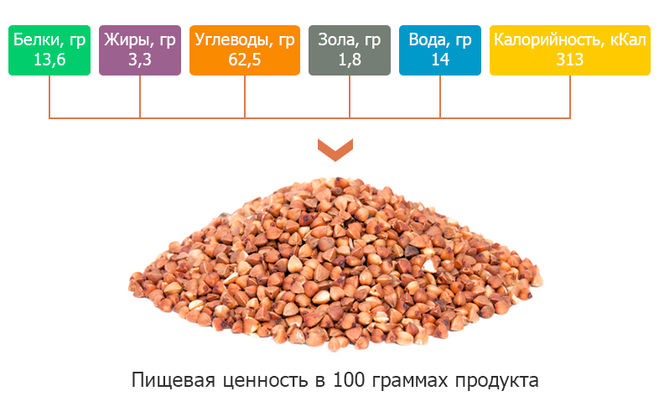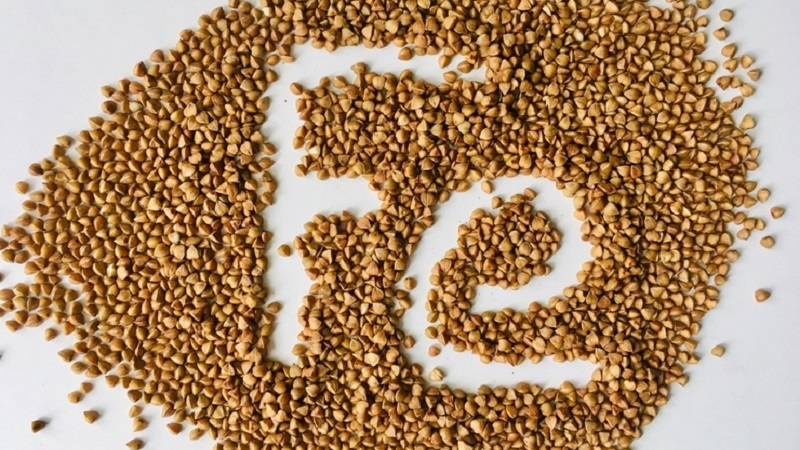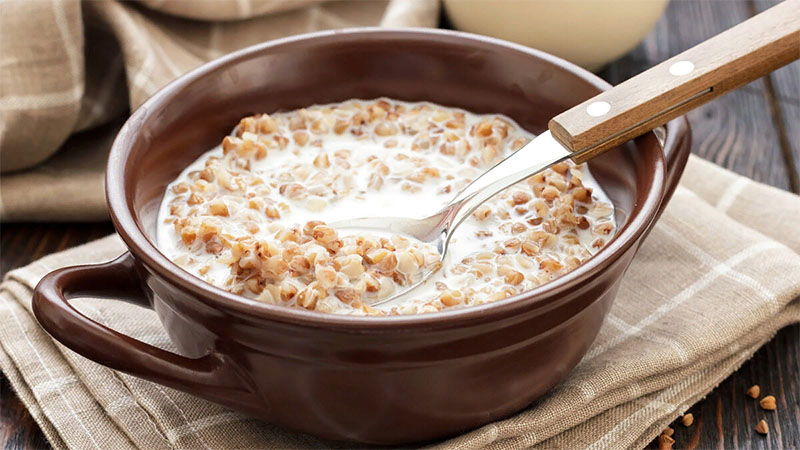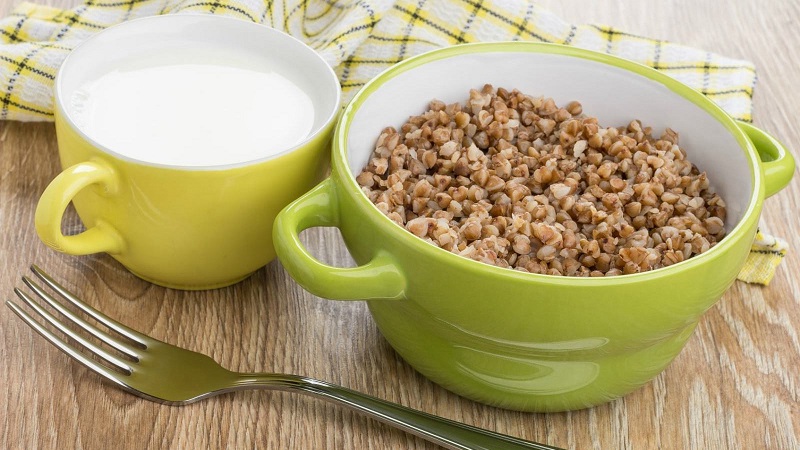How many proteins, fats and carbohydrates are in buckwheat and what else is it rich in?
Buckwheat porridge is a dietary product. It is high in calories and nutritious, contains carbohydrates, which are converted into energy, and not deposited in subcutaneous fat. In the article we will tell you how many carbohydrates, fats and proteins are in boiled and raw buckwheat and what useful properties it has.
The content of the article
Buckwheat composition

Buckwheat porridge - a dietary hypoallergenic product - is considered a national dish in our country. It is included in the diet of schoolchildren, in the menu of infants from the first complementary foods. Cereals are especially useful for athletes, pregnant women, people with diabetes.
Reference. Buckwheat is the seeds of buckwheat. This is a pseudo-grain grain melliferous crop, a herbaceous plant of the Buckwheat family. "Black rice" has been consumed for over 5 thousand years.
Proteins, fats and carbohydrates
Consider the content of proteins, fats and carbohydrates (BJU) in a dry product and a cooked dish.
| Composition per 100 g of product | Groats, g | Porridge on the water, g |
|---|---|---|
| Protein | 10,8 | up to 4 |
| Fats | 3,2 | 0,63-1 |
| Carbohydrates | up to 56 | 19, 51 |
| BZHU ratio,% | 15,7:3,19:80,2 | 15,6:7,4:77,2 |
The calorie content of dry kernel is 308-310 kcal.
Council. Nutritionists and experts of Roskontrol on safety and quality of foodstuffs recommend using the kernel - whole grain cereals. In uncrushed grains, in contrast to chaff and flour, there are more useful substances.
Useful material
In addition to proteins, fats and carbohydrates, buckwheat contains rare micro and macro elements. For example, manganese is responsible for the transmission of nerve impulses, magnesium prevents platelets from sticking together, improves blood flow, and reduces the risk of blood clots.
Attention! During heat treatment, the loss of minerals is 25-60%.
| Minerals | Core | Porridge on water (no additives and salt) |
|---|---|---|
| Potassium, mg | 380 | 126,14 |
| Calcium, mg | 20 | 10,3 |
| Silicon, mg | 81 | 27,44 |
| Magnesium, mg | 199 | 67,2 |
| Sodium, mg | 3 | 1,71 |
| Sulfur, mg | 87 | 30,6 |
| Phosphorus, mg | 295 | 99 |
| Chlorine, mg | 34 | 12,3 |
| Iron, mg | 6,6 | 2,22 |
| Manganese, mg | 1,57 | 0,53 |
| Iodine, mcg | 3,4 | 1,2 |
| Cobalt, μg | 3,2 | 1,03 |
| Copper, mcg | 635 | 217,3 |
| Molybdenum, mcg | 34,2 | 11,7 |
| Nickel, mcg | 10,2 | 3,4 |
| Selenium, mcg | 5,7 | 2,82 |
| Titanium, mcg | 33 | 11,2 |
| Fluorine, μg | 22 | 88,43 |
| Chromium, mcg | 4,2 | 1,35 |
| Zinc, mcg | 2,1 | 0,7 |
| Boron, mcg | 350 | — |
| Vanadium, mcg | 160 | — |
| Lithium, mcg | 4,1 | — |
| Rubidium, mcg | 53 | — |
| Aluminum, mcg | 33 | — |
| Strontium, μg | 301 | — |
| Zirconium, mcg | 34 | — |
What else is contained in buckwheat

Buckwheat contains 11 g of fiber (56% of the daily value). In a 100 g portion of ready-made porridge - up to 4 g (20% of the daily dose).
Coarse fiber does not dissolve, is retained in the large intestine and removes toxins, harmful cholesterol, carcinogens, harmful bacteria that enter the intestines with food.
Vitamin composition
What buckwheat is rich in:
- A - 2 μg;
- beta-carotene - 0.01 mg;
- B1 - 0.43 mg;
- B2 - 0.2 mg;
- B4 - 54.1 mg;
- B5 - 0.43 mg;
- B6 - 0.4 mg;
- B9 - 32 mcg;
- PP - up to 4 mg;
- E - 0.8 mg;
- H - 10 μg;
- K - up to 7.5 μg.
Fat-soluble vitamins (E, K, A) remain up to 80% when buckwheat is steamed in a small amount of boiling water. Water-soluble vitamins of group B, PP, when heated, lose their value by 20-30% (turn into a decoction).
Buckwheat contains fatty acids that protect the body from viruses and bacteria. For example, stearic and linolenic acids protect against ultraviolet radiation and prevent the formation of cancer cells.
Also, grains contain essential and nonessential amino acids - regulators of hormones and metabolic processes.
Thanks to the content of rutin, buckwheat strengthens the vascular wall. To achieve a preventive effect, the product is consumed at least 2-3 times a week.
Calorie content of boiled porridge

100 g of boiled buckwheat contains 97-100 kcal.
Calculating calorie content of the finished dish, take into account the method of preparation and additives (per 100 g):
- porridge on water with added salt - up to 110 kcal;
- with butter (up to 3-5 g) - up to 140 kcal;
- cooked in milk with the addition of 1 tsp.sugar - 190-200 kcal;
- with boiled chicken and vegetables - up to 160 kcal.
For the convenience of calculating the daily ration, the measured indicators of buckwheat porridge are used:
- 1 tsp - up to 5 g;
- 1 tbsp. l. - 18-20 g.
It is interesting:
Calorie content and BZHU of boiled buckwheat with milk
Calorie content and BZHU of boiled buckwheat
Calorie content of buckwheat, potatoes and millet - which one is healthier
Buckwheat is a protein or carbohydrate

Glycemic index of buckwheat low - up to 40 units.
Reference. The glycemic index (GI) is a relative measure of the rate of absorption of carbohydrates, affecting blood sugar levels.
Buckwheat, vegetables, cottage cheese, etc. foods with a low GI are classified as complex (slow) carbohydrates. They slowly release energy, provide a store of glycogen (glucose molecules) in the muscles and liver. It is a reserve, beneficial "fuel" for muscles that is used for metabolism.
Benefits of slow (complex) carbohydrates:
- lower blood glucose levels;
- eliminate sudden surges in sugar;
- provide long-term satiety (no feeling of hunger);
- stabilize the insulin index (normalize insulin synthesis);
- reduce the level of bad cholesterol;
- have a positive effect on bowel function due to fiber;
- keep the balance of the bacterial microflora of the large intestine (act as a prebiotic).
Fast carbohydrates with a high glycemic index (rice, white bread, chips, muesli, semolina) negatively affect metabolism. When consumed in excess, they are processed into fat reserves. This provokes an increase in body weight and the development of diabetes mellitus.
Reference. The daily consumption rate of buckwheat is not more than 200 g per day.
Buckwheat has no fast-digesting sugar and glucose. The product provides the necessary energy for sports, physical activity. But it is important to take into account the dose - no more than 200 g per day.
Conclusion
Buckwheat is an inexpensive and healthy grain. It is a dietary product that does not cause allergies and negative reactions in children and people with diabetes. Has a low glycemic index. Complex carbohydrates are absorbed slowly without being stored in fat. Along with buckwheat, vegetables, herbs and fruits are included in the diet.